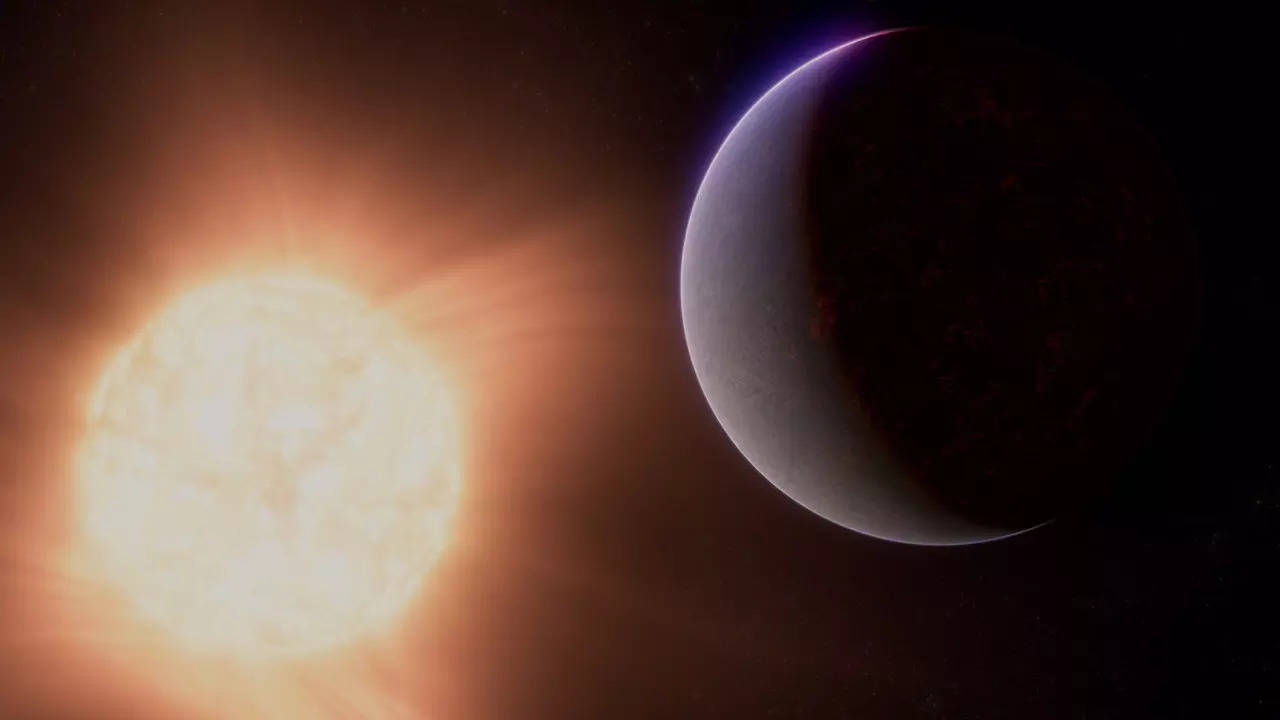[ad_1]
“It’s probably the firmest evidence yet that this planet has an atmosphere,” said Ian Crossfield, an astronomer who was not involved with the research, published in the journal Nature. Super Earth refers to a planet’s size – bigger than Earth but smaller than Neptune. The boiling temperatures on this planet – which can reach as hot as 2,300C – mean that it is unlikely to host life.
Instead, scientists say the discovery is a promising sign that other such rocky planets with thick atmospheres could exist that may be more hospitable. The exoplanet 41 light years away is eight times heavier than Earth and circles its star Copernicus so closely that it has permanent day and night sides. A light-year is nearly 9.7 trillion kms. Its surface is encrusted with magma oceans.
To identify the makeup of its atmosphere, researchers studied Webb Space Telescope observations before and after the planet passed behind its star. They separated the light emitted from the planet versus its star and used the data to calculate the planet’s temperature. There’s evidence the planet’s heat was being distributed more evenly across its surface – a party trick atmospheres are known for. Gases from its magma oceans may play a key role in holding its atmosphere steady. Exploring this super Earth may also yield clues to how Earth and Mars might have evolved. “It’s a rare window,” said Renyu Hu from Nasa’s Jet Propulsion Lab, who was part of the research.
function loadGtagEvents(isGoogleCampaignActive) { if (!isGoogleCampaignActive) { return; } var id = document.getElementById('toi-plus-google-campaign'); if (id) { return; } (function(f, b, e, v, n, t, s) { t = b.createElement(e); t.async = !0; t.defer = !0; t.src = v; t.id = 'toi-plus-google-campaign'; s = b.getElementsByTagName(e)[0]; s.parentNode.insertBefore(t, s); })(f, b, e, 'https://www.googletagmanager.com/gtag/js?id=AW-877820074', n, t, s); };
function loadSurvicateJs(allowedSurvicateSections = []){ const section = window.location.pathname.split('/')[1] const isHomePageAllowed = window.location.pathname === '/' && allowedSurvicateSections.includes('homepage')
if(allowedSurvicateSections.includes(section) || isHomePageAllowed){ (function(w) { var s = document.createElement('script'); s.src="https://survey.survicate.com/workspaces/0be6ae9845d14a7c8ff08a7a00bd9b21/web_surveys.js"; s.async = true; var e = document.getElementsByTagName('script')[0]; e.parentNode.insertBefore(s, e); })(window); }
}
window.TimesApps = window.TimesApps || {};
var TimesApps = window.TimesApps;
TimesApps.toiPlusEvents = function(config) {
var isConfigAvailable = "toiplus_site_settings" in f && "isFBCampaignActive" in f.toiplus_site_settings && "isGoogleCampaignActive" in f.toiplus_site_settings;
var isPrimeUser = window.isPrime;
if (isConfigAvailable && !isPrimeUser) {
loadGtagEvents(f.toiplus_site_settings.isGoogleCampaignActive);
loadFBEvents(f.toiplus_site_settings.isFBCampaignActive);
loadSurvicateJs(f.toiplus_site_settings.allowedSurvicateSections);
} else {
var JarvisUrl="https://vsp1jarvispvt.indiatimes.com/v1/feeds/toi_plus/site_settings/643526e21443833f0c454615?db_env=published";
window.getFromClient(JarvisUrl, function(config){
if (config) {
loadGtagEvents(config?.isGoogleCampaignActive);
loadFBEvents(config?.isFBCampaignActive);
loadSurvicateJs(config?.allowedSurvicateSections);
}
})
}
};
})(
window,
document,
'script',
);
[ad_2]
Source link






